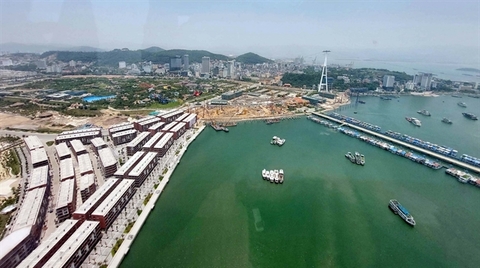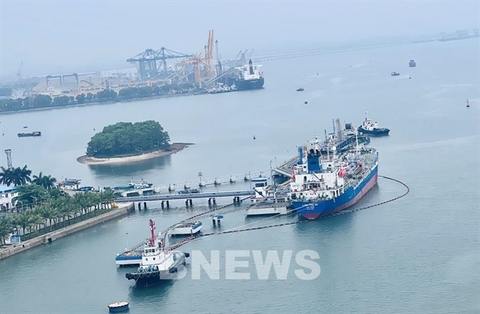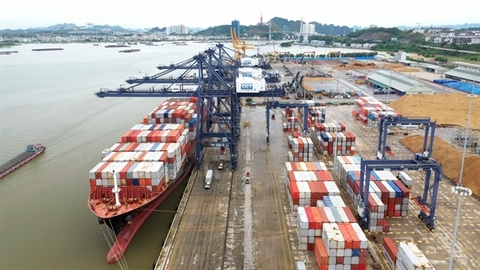
An overview of Ha Long international passenger port. VNA/VNS Photo Thanh Van
Quang Ninh will give top priority to positioning the brand name of its seaports and seaport services in both domestic and international markets in a bid to reach the full potential of its deep-water seaports in the coming years, the provincial Maritime Administration said.
With its outstanding advantages to develop seaports and seaport services, Quang Ninh province is taking bold steps to implement a breakthrough seaport growth strategy in the next years, contributing to the development of the marine economy for the province and the country’s northern economic region.
The province will focus on accelerating the completion of transport infrastructure projects at key ports to attract resources to further invest in seaport infrastructure, especially port connectivity works, it said.
Untapped potential
According to the Ministry of Transport, Quang Ninh has enormous potential to develop its marine economy given its 250km coastline and many deep-water ports. In particular, the province, located in the Two Corridors, One Belt cooperation area, is also a gateway connecting ASEAN with China and international shipping routes.
The province’s seaports now handle over 40 per cent of the total volume of cargo and passengers in the northern region, mainly coal, petroleum, bulk cargo for agriculture, construction materials, import and export goods, equipment and industrial machinery.

Quang Ninh targets to attract resources to further invest in seaport infrastructure, especially port connectivity works. VNA/VNS Photo Quang Toan
With its advantages, the province has positioned the marine economy as a spearhead of its service-industrial development. In 2019, the province issued Resolution 15-NQ/TU with a roadmap for seaports and seaport service development for the period of 2019-2025 and 2026-2030, and up to 2045.
It targets respective seaport growth rates of 17.5 and 18.5 per cent for the first two periods.
Official statistics from the administration showed that despite the COVID-19 pandemic’s impact, seaport operations and revenue remained stable and the import and export of goods by has grown strongly from the end of 2021.
In the first period, the local seaports annually handled over 104 million tonnes of goods and raked in nearly VND7.5 trillion (US$324 million) from related services.
In particular, Quang Ninh has focused on developing a synchronous seaport system, which connects with other modes of transport to reduce transportation time and costs.
Currently, 13 ports in the province have been upgraded and added to the master plan for development of Viet Nam's seaport system in the 2021-2030 period, with a vision to 2050.
This is a very important basis for prioritising land earmarked for logistics and post-port logistics services development, thereby attracting investors to research and develop local seaports.
Nguyen Xuan Sang, Deputy Minister of Transport, said Quang Ninh’s seaports were one of the nation's leading facilities serving the key northern economic region.
New seaports would help turn it into an important hub on the international maritime map and form strategic shipping routes, he noted.

Marshall Islands-flagged Synergy Busan, with a loading capacity of over 50,000 tonnes, docks at Cai Lan Port in the northern province of Quang Ninh. — VNA/VNS Photo Thanh Van
On October 24, 2021, Van Ninh Port began construction in the city of Mong Cai. The project, covering an area of more than 82 hectares at a cost of over VND2.2 trillion in its first phase, has a main wharf of 500m with capacity to accommodate two ships of 20,000 DWT or three 10,000 DWT ships. Additional works, such as wharves, bridges and warehouses with international standards, will also be built.
The port is expected to be put into use in the fourth quarter of 2024.
This September, Cai Lan Port marked an important event when it welcomed a ship with a loading capacity of over 50,000 tonnes to dock at the port. The port has developed a service of loading and unloading ultra-large cargo up to 100 tonnes with crane hooks.
Patrick P. Avice, General Director of Cai Lan International Container Terminal Limited Liability Company, said the company determined that this would be an international standard container port with professional management and operation technology as well as equipment for the most modern cargo container handling process, which could be up to 1,200,000 TEU annually.
Wharves No. 3 and 4 are capable of receiving ships of 50,000 tonnes while wharves No. 1, 5, 6, 7 have been invested in to increase loading and unloading capacity to 60 containers per hour.
In 2022, Quang Ninh strives to basically complete the first phase of Van Ninh Port and accelerate the construction of seaport infrastructure in Nam Tien Phong, Bac Tien Phong, Dam Nha Mac in the Quang Yen coastal economic zone.
Overcoming challenges
Despite advantages, seaport operations in Quang Ninh still face many difficulties, leading to weak competition and a shortage of cargo sources.
In most of the ports, the volume of cargo remains quite modest. Foreign shipping lines are still hesitant when choosing between seaports of the province and that of Hai Phong.
According to Dinh Anh Tuan, Deputy General Director of Quang Ninh Port JSC, the distance from the ports in Quang Ninh to the northern provinces is not longer than that from Hai Phong.
Although Quang Ninh has the advantage of receiving ultra-large ships, the seaport infrastructure remains limited, causing high transport costs and discouraging shipping lines.
Moreover, maritime services that require high qualifications such as repairing and maintaining ship machinery, diving and surveying hulls are challenges for the local seaports. Some still ask for support from Hai Phong’s seaports.
To solve these issues, the Quang Ninh Port Authority said the province would create long-term development orientations for each port in association with industrial parks.
It would also continue its administrative reforms, creating the best conditions possible for ship owners and businesses to operate in local ports.
The province also needed to have a sustainable support policy for ship owners, shipping companies, and owners of transport vehicles; and work to diversify the services offered, said the authority. – VNS